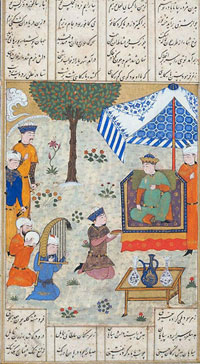The Khamsa of Nizami Persia |
An Innovative Approach to Art History
click on image to enlarge
The idea behind this project, devised by staff at the Dalton School in New York City, was to explore the potential of using innovative computer technologies to begin to define a new approach to teaching art history. In this case, the goal was a demonstration of how the Institute could take a fundamentally two-dimensional artwork depicting one scene from the Khamsa and create an interactive three-dimensional tool for teaching about various aspects of Medieval Persian literature, and of depicting perspective, status, and class hierarchy, as well as allow students to learn about objects of the royal court.

One page from the Khamsa of Nizami as depicted in a 15th-century version of the story. |
More specifically, we were to focus on a single leaf from the story. The particular image chosen was provided to the Dalton School from AMICO (the Art Museum Image Consortium), of which the School is a member.
The image comes from the original in the Boston Museum of Fine Arts (accession #60.176), a gift of John Goelet. It is Safavid period (early 16th century) version of the story (the page is on paper measuring 33.5 x 20.3cm (c. 13 3/16 x 8 in.).
This particular page has fourteen verses, rhymed in the epic style - every hemistich rhymes only with its own counterpart. The poetic form here is called the masnavi form; it is not one of Nizami’s gassidas or gazals. These verses seem randomly descriptive, with no proper names or places, and the specific context of this part of the story is unclear. The gist is festive and very grand, describing a young king waking, and people celebrating with wine being served. It expounds on the beauty of Nature and eulogizes the king.
Reference
Page Created: October 5, 2004
Page Updated: August 16, 2010
URL:
Page Author: The Institute for the Visualization of History